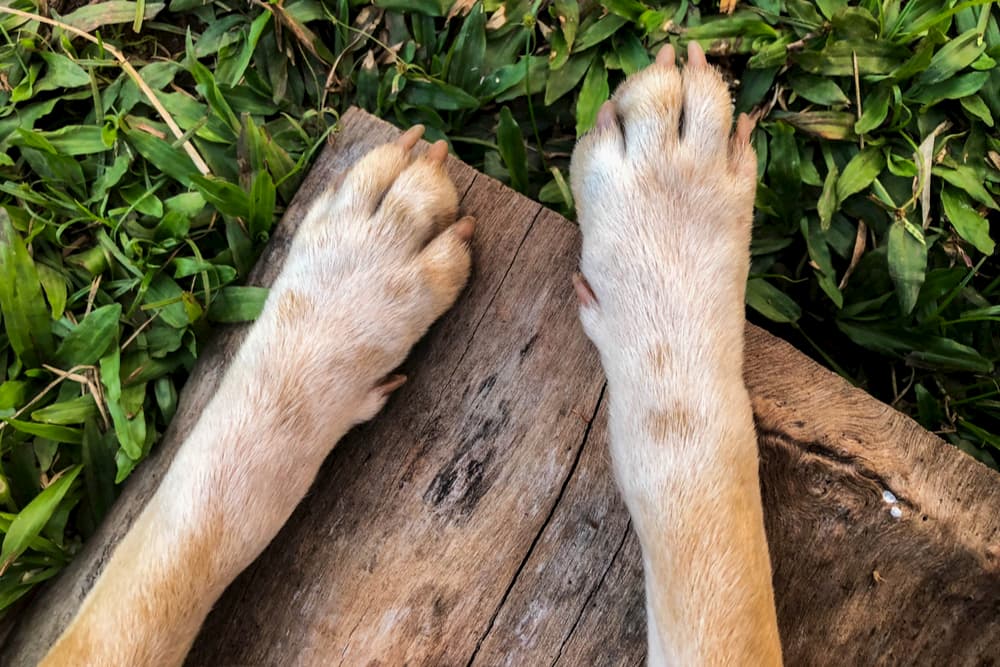7 Ways to Tell Your Dog’s Nails Are Too Long

Nail care is an often overlooked aspect of our pet’s healthcare. But nail trims are just as important as any other part of a dog’s overall care regimen. However, figuring out when it’s time to trim your dog’s nails might not be super intuitive.
You might notice your dog’s nails are too long when they scratch you or when they begin to get caught on the furniture, but there are other signs that it’s time to get out the clippers or head to the groomer.
Paying attention to your dog’s nails and keeping them at an appropriate length can save you and your dog the pain of dealing with overgrown nails.
Dog Nail Care: Why It’s Important

Dog nail care is important because it keeps your pet walking, running, and moving around comfortably. When your dog’s nails are too long, they create an unnatural angle for the foot. This causes unequal pressure on the toes and can cause the nail beds to become sore and tender.
Long nails on dogs are more prone to splitting and/or splintering. This is the equivalent of a human hangnail. It is not only extremely painful, but it can even warrant a trip to the veterinary clinic. The veterinarian will use sedation and pain medications to pull the hangnail and then bandage the foot to prevent infection in your dog’s nail bed.
Dogs with long nails will sometimes slip on hardwood or tile floors or walk gingerly to cope with the circumstances. Nail care is especially important in our older canine companions or pets with arthritis.
Keeping your dog’s nails at an acceptable length also protects you and your belongings. Have you ever been scratched by your dog after he jumps up on you? Or have you seen the couch or other furniture snag when your dog jumps off? Overgrown nails can also get caught on things causing your dog unnecessary pain.
How Long Should Dog Nails Be?

Dog’s nails should extend enough to be seen, but should not go past the paw. If your dog has long hair, you may not be able to easily see the nails. But if the nails extend over the bottom of the paw pad you’ll know your dog’s nails are too long.
You can also look for the nail quick and use it as a guide for how short to trim your dog’s nails. The nail quick houses nerves and blood supply. Hitting the quick on your dog is painful and will cause him to bleed, so you don’t want to cut into the quick.
This is one reason why regular nail trims are important. When your pet’s nails grow long, the quick of the nail grows with it. In these cases, it’s easier to hit the quick and harder to trim the nails short again.
Extremely overgrown dog nails will curl over the paw. This is when pet parents should definitely consider a mani/pedi for their pup.
And don’t forget about the dewclaw! The dewclaw, which sits up higher on your dog’s leg, also has a nail. Since it sits higher up on the leg, the nail doesn’t get worn down on pavement or walks like other nails. This is the nail that will usually curl over and needs to be trimmed regularly.
Always keep your dog’s nails at an acceptable length to prevent the quick from growing out and to keep your dog comfortable.
Signs Your Dog’s Nails Are Too Long

If you’re wondering whether it’s time for a trim, here are some signs that your dog’s nails are too long.
Your Dog’s Nails Are Scratching You
Your dog may paw at you when he wants attention, but he shouldn’t scratch you. If you are being scratched each time your dog touches you, his nails are too long. At the correct length and when nails are filed down, you shouldn’t feel his nails.
Your Dog’s Nails Click on the Floor

You can hear your dog walking around the house: If you have hardwood floors, the sounds of screeching or clicking nails on the wood are an indicator that it is time for a nail trim. Your dog should be able to walk around the house without his nails dragging on the floor.
Your Dog Looks Like He’s Tip-Toeing
You may notice your dog walking gingerly or “tip-toeing” with his nails on the ground and his paw elevated. This is a sign that his nails are extremely overgrown. Your dog’s paws should always be able to touch the ground when he is walking.
Your Dog’s Nails Curl Over His Paw

A dog’s nails should sit right at the level of his paw. If they are curling over his paw or curling at all, it’s time for a nail trim. This is especially important for the dewclaw since it does not get worn down by regular walking.
Your Dog Slides on the Floor
If your dog is sliding on the floor, his nails are probably causing a lot of instability. This usually happens when the nails are extremely overgrown, and his paw is not touching the ground for him to grip. His instability and sliding can lead to other injuries such as a joint luxation or a hairline fracture.
Your Dog is Limping
If your dog seems to be walking gingerly or limping, check to see if his nails are at the appropriate length. He may be in pain and is favoring one leg over another.
Your Dog Licks His Paws a Lot

Your dog may lick at his paws for a variety of reasons including pain, but if you check his nails and they are too long, a trim might solve the problem.
Your Dog’s Nail Bed is Red or Bleeding
If your dog is bleeding or has redness at his nail bed it could signal an infection. His nails may be overdue for a trim or in need of some serious care.
What to Do if Your Dog’s Nails Are Too Long

If your dog’s nails are too long you can always contact your veterinarian or groomer for a nail trim. This is especially important for dogs that don’t like having their paws touched or are hard to handle during nail trims.
You can also do at-home nail trims using nail clippers or nail grinders. For at-home nail trims you’ll want to be sure you are using clippers that are appropriate for your dog’s size or you might cut off too much of the nail too quickly. You’ll also want to have a product called Kwik Stop readily available in case you hit the quick of the nail. This stops the bleeding in a timely manner.
Once you cut your dog’s nails to the right length, taking your pup on longer walks or allowing him to spend more time running around outside will help keep his nails filed down for longer periods of time between trims.









